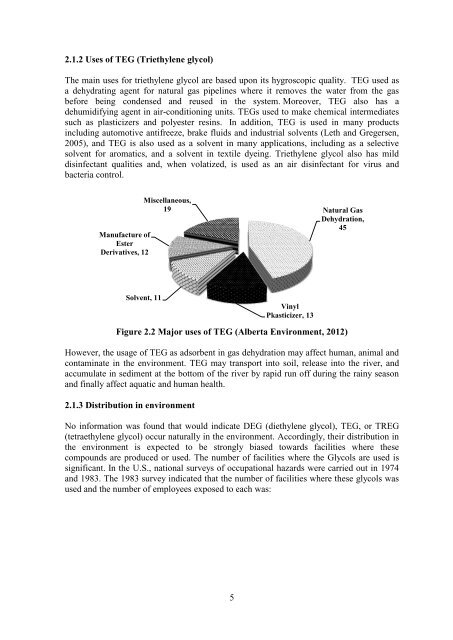Membrane Based Triethylene Glycol Separation and Recovery from ...
Membrane Based Triethylene Glycol Separation and Recovery from ...
Membrane Based Triethylene Glycol Separation and Recovery from ...
You also want an ePaper? Increase the reach of your titles
YUMPU automatically turns print PDFs into web optimized ePapers that Google loves.
2.1.2 Uses of TEG (<strong>Triethylene</strong> glycol)<br />
The main uses for triethylene glycol are based upon its hygroscopic quality. TEG used as<br />
a dehydrating agent for natural gas pipelines where it removes the water <strong>from</strong> the gas<br />
before being condensed <strong>and</strong> reused in the system. Moreover, TEG also has a<br />
dehumidifying agent in air-conditioning units. TEGs used to make chemical intermediates<br />
such as plasticizers <strong>and</strong> polyester resins. In addition, TEG is used in many products<br />
including automotive antifreeze, brake fluids <strong>and</strong> industrial solvents (Leth <strong>and</strong> Gregersen,<br />
2005), <strong>and</strong> TEG is also used as a solvent in many applications, including as a selective<br />
solvent for aromatics, <strong>and</strong> a solvent in textile dyeing. <strong>Triethylene</strong> glycol also has mild<br />
disinfectant qualities <strong>and</strong>, when volatized, is used as an air disinfectant for virus <strong>and</strong><br />
bacteria control.<br />
Manufacture of<br />
Ester<br />
Derivatives, 12<br />
Miscellaneous,<br />
19<br />
Solvent, 11<br />
Figure 2.2 Major uses of TEG (Alberta Environment, 2012)<br />
However, the usage of TEG as adsorbent in gas dehydration may affect human, animal <strong>and</strong><br />
contaminate in the environment. TEG may transport into soil, release into the river, <strong>and</strong><br />
accumulate in sediment at the bottom of the river by rapid run off during the rainy season<br />
<strong>and</strong> finally affect aquatic <strong>and</strong> human health.<br />
2.1.3 Distribution in environment<br />
No information was found that would indicate DEG (diethylene glycol), TEG, or TREG<br />
(tetraethylene glycol) occur naturally in the environment. Accordingly, their distribution in<br />
the environment is expected to be strongly biased towards facilities where these<br />
compounds are produced or used. The number of facilities where the <strong>Glycol</strong>s are used is<br />
significant. In the U.S., national surveys of occupational hazards were carried out in 1974<br />
<strong>and</strong> 1983. The 1983 survey indicated that the number of facilities where these glycols was<br />
used <strong>and</strong> the number of employees exposed to each was:<br />
5<br />
Vinyl<br />
Pkasticizer, 13<br />
Natural Gas<br />
Dehydration,<br />
45

















